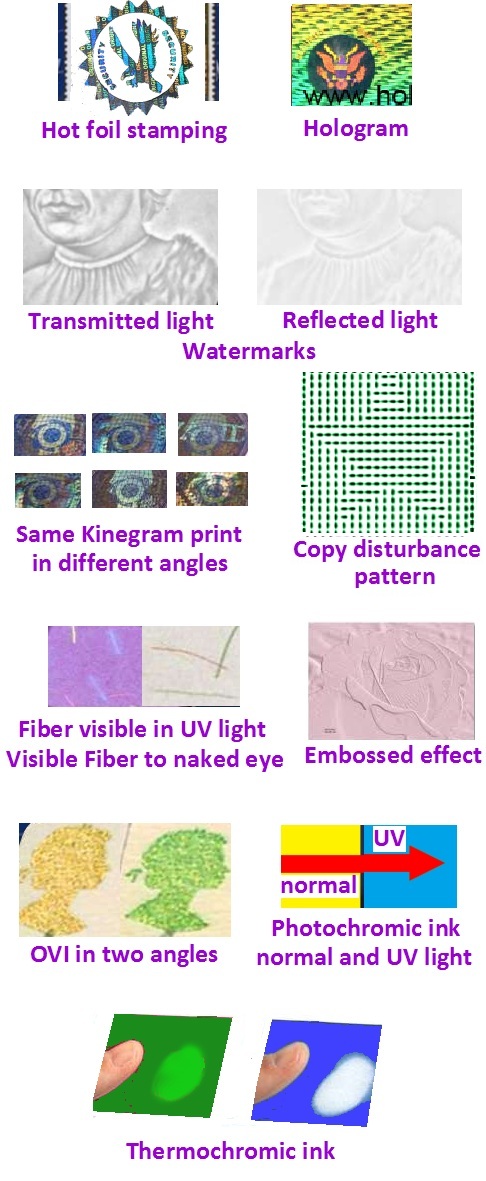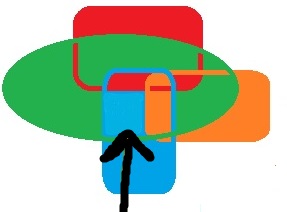
Counterfeiting menace – 3
Counterfeiting menace
on printed documents
Written by : N.R. Jayaraman
This article spread over to three or four parts discuss the
nature of security features found on the security documents
and other commercial documents of various kinds.
III
10) Color Shifting Ink changes color depending on the viewing angle, producing unique chromatic effects. These inks are made with special pigments that change color as the viewing angle changes. Works very well with digital print systems. These are used both on Security documents and on the cartons of the consumer and Pharmaceutical products, the brand protection labels etc.
11) Thermochromatic Ink solutions that change colors when a set temperature is reached. Cannot be scanned or duplicated easily. These inks are used both on Security documents and on the cartons of the consumer and Pharmaceutical products, the brand protection labels etc.
12) UV glowing called Ultraviolet additives are invisible to the naked eye and react to only UV lights for authentication purposes. Can also contain custom embedded messages and brand logos. These additives are added with inks used both on Security documents and on the cartons of the consumer and Pharmaceutical products, the brand protection labels etc.
13) One of the most recent development among the security features, which is alike with the UV-glowing, is the IR-glowing (Infra Red). Some areas of the banknote are printed with this special ink which makes the picture darker under the IR rays. IR Additives is Infrared additives that react to specific wavelengths that are machine or light source readable. Very hard to detect and almost impossible to duplicate. This feature being very costly is used only on Security documents and not on the cartons of the consumer and Pharmaceutical products, the brand protection labels etc.
14) Diffractive images, are often referred to as holograms, but are in fact images created by small areas of fine lines or fringes. When illuminated by light, each small array of lines reflects a rainbow of colors from the surface at a specific angle. An image is made by creating a large number of such arrays at different orientations with multiple overlapping rainbow effects. This is known to be used only on the cartons of the consumer and Pharmaceutical products, the brand protection labels etc.
15) Taggant is a marker powder which is added with the printing inks to enhance the security feature. Taggants act as a marker which can be read or the presence detected only by a special device which will be specially designed to authenticate them. Taggants are microscopic or nano materials that are uniquely encoded and virtually impossible to duplicate. They will act as human finger prints which can not be duplicated. They are specially formulated chemicals and physically ground to nano particle sizes to prevent duplication. Since these are proprietary product of only few firms – each have their own reader to authenticate the taggant- his is known to be extensively used on Blister packs of medicines and other highly consumed goods mostly printed by flexography.
16) Microperfing is Laser Perforating System of applying small elliptical holes, extremely difficult to create and is used as security feature on Bank Notes and Currencies to create numbers. The holes are arranged to form predetermined patterns and cannot be created by any mechanical means. The micro-perforated pattern is not visible when looking down on a note, but is clearly visible when the note is held up against the light. Checking for this security feature is comparable to checking for a watermark. Except on Currencies and Bank notes this feature has not been found in other documents or applications.
17) Blister packs are commonly used as unit-dose packaging for pharmaceutical tablets, capsules or lozenges. Blister packs provide barrier protection for shelf life requirements, and a degree of tamper resistance. Printing a dot matrix code on blister packs is one of the best security feature. The dot matrix code is best applied during the blister production process because an additional surface coating then prevents manipulation. The information can be read using commercially available scanners. The dot matrix code also allows coded information that is known only to the manufacturer to be placed on the foil. Numerous security printing inks cannot be used on the inside of the blisters for health reasons. The same is true in principle for the reverse side if it does not exhibit the required barrier properties. Only security pigments for printing inks that have been approved for use in contact with foodstuffs can be used. Therefore the other best security feature applied on the blister packs are the taggants mixed with the flexo ink printed on top of the blister packs. A new development to incorporate the 2D/3D images as security feature has emerged to produce conventional blister foils that cover the whole area.
In addition to the standard features which have been discussed above some of the specialized firms in the field of printing and processing have also come out with their own version of features which have been patented. I have reproduced in the concluding part a brief on them for educational purpose and for more details the concerned firms should only be contacted.
13) One of the most recent development among the security features, which is alike with the UV-glowing, is the IR-glowing (Infra Red). Some areas of the banknote are printed with this special ink which makes the picture darker under the IR rays. IR Additives is Infrared additives that react to specific wavelengths that are machine or light source readable. Very hard to detect and almost impossible to duplicate. This feature being very costly is used only on Security documents and not on the cartons of the consumer and Pharmaceutical products, the brand protection labels etc.
14) Diffractive images, are often referred to as holograms, but are in fact images created by small areas of fine lines or fringes. When illuminated by light, each small array of lines reflects a rainbow of colors from the surface at a specific angle. An image is made by creating a large number of such arrays at different orientations with multiple overlapping rainbow effects. This is known to be used only on the cartons of the consumer and Pharmaceutical products, the brand protection labels etc.
15) Taggant is a marker powder which is added with the printing inks to enhance the security feature. Taggants act as a marker which can be read or the presence detected only by a special device which will be specially designed to authenticate them. Taggants are microscopic or nano materials that are uniquely encoded and virtually impossible to duplicate. They will act as human finger prints which can not be duplicated. They are specially formulated chemicals and physically ground to nano particle sizes to prevent duplication. Since these are proprietary product of only few firms – each have their own reader to authenticate the taggant- his is known to be extensively used on Blister packs of medicines and other highly consumed goods mostly printed by flexography.
16) Microperfing is Laser Perforating System of applying small elliptical holes, extremely difficult to create and is used as security feature on Bank Notes and Currencies to create numbers. The holes are arranged to form predetermined patterns and cannot be created by any mechanical means. The micro-perforated pattern is not visible when looking down on a note, but is clearly visible when the note is held up against the light. Checking for this security feature is comparable to checking for a watermark. Except on Currencies and Bank notes this feature has not been found in other documents or applications.
17) Blister packs are commonly used as unit-dose packaging for pharmaceutical tablets, capsules or lozenges. Blister packs provide barrier protection for shelf life requirements, and a degree of tamper resistance. Printing a dot matrix code on blister packs is one of the best security feature. The dot matrix code is best applied during the blister production process because an additional surface coating then prevents manipulation. The information can be read using commercially available scanners. The dot matrix code also allows coded information that is known only to the manufacturer to be placed on the foil. Numerous security printing inks cannot be used on the inside of the blisters for health reasons. The same is true in principle for the reverse side if it does not exhibit the required barrier properties. Only security pigments for printing inks that have been approved for use in contact with foodstuffs can be used. Therefore the other best security feature applied on the blister packs are the taggants mixed with the flexo ink printed on top of the blister packs. A new development to incorporate the 2D/3D images as security feature has emerged to produce conventional blister foils that cover the whole area.
In addition to the standard features which have been discussed above some of the specialized firms in the field of printing and processing have also come out with their own version of features which have been patented. I have reproduced in the concluding part a brief on them for educational purpose and for more details the concerned firms should only be contacted.
SOME OF THE SECURITY FEATURES
AT A GLANCE

………..to be continued














Recent Comments